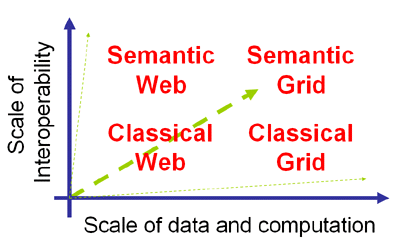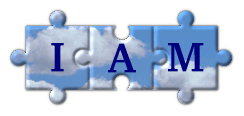Semantic Grid Vision
 The Grid is sometimes heralded as
the next generation of the Internet or the Web. Meanwhile, Semantic Web
is heralded as the future of the Web. Are these orthogonal futures?
We believe they are not. Fundamentally, they are both about joining
resources together in order to achieve new things.
The Grid is sometimes heralded as
the next generation of the Internet or the Web. Meanwhile, Semantic Web
is heralded as the future of the Web. Are these orthogonal futures?
We believe they are not. Fundamentally, they are both about joining
resources together in order to achieve new things.
Every time we embark on a new Grid computing exercise, we would like to
reuse and repurpose the available services, data, workflows and indeed
knowledge, from our own research communities and elsewhere. Where we
once needed the Grid to hide the heterogeneity of computational resources,
the new Grid problem is to assemble new services, or even new Grids,
quickly, easily and as automatically as possible from diverse
resources - the dynamic creation of virtual organisations.
Our vision is of a generically useable e-Research infrastructure, comprised
of easily deployed components whose utility transcends their immediate
application, providing a high degree of easy-to-use and seamless automation
and in which there are flexible collaborations and computations on a
global scale.
The key to this is an infrastructure where all resources, including
services, are adequately described in a form that is machine-processable,
i.e. knowledge is explicit -
the goal is semantic interoperability.
One way of achieving this is to apply Semantic Web technologies in Grid
computing developments, from the machinery of the Grid infrastructure (such
as Grid services) up to the Grid applications. It is important to note that
the 'semantics' permeates the full vertical extent of the Grid and is not
just a semantic (or knowledge) layer on top: it is semantics in, on and for
the Grid.
We call this vision the Semantic Grid.
To illustrate the symbiosis of
these ideas, consider this view of Grid computing (from The Anatomy of
the Grid: Enabling Scalable Virtual Organizations" by Foster,
Kesselman and Tuecke):
"Grid computing has emerged as an important
new field, distinguished from conventional distributed computing by
its focus on large-scale resource sharing, innovative applications,
and, in some cases, high-performance orientation...we review the
"Grid problem", which we define as flexible, secure, coordinated
resource sharing among dynamic collections of individuals,
institutions, and resources - what we refer to as virtual
organizations."
alongside this description of
the Semantic Web from the W3C Semantic Web Activity Statement
(November 2001):
"The Semantic Web is an extension of the
current Web in which information is given well-defined meaning,
better enabling computers and people to work in cooperation. It is
the idea of having data on the Web defined and linked in a way that
it can be used for more effective discovery, automation,
integration, and reuse across various applications. The Web can
reach its full potential if it becomes a place where data can be
shared and processed by automated tools as well as by
people.
As the Semantic Web is to the
Web, so is the Semantic Grid to the Grid.
By analogy with the Semantic Web, the Semantic Grid is an extension of
the current Grid in which information and services are given well-defined
meaning, better enabling computers and people to work in cooperation.
Rather than orthogonal
activities, we see the emerging Semantic Web infrastructure as an
infrastructure for Grid computing, permeating all aspects of the
Grid from infrastructure to applications.
The report "Research Agenda for the Semantic Grid: A Future
e-Science Infrastructure" (see
documents) was written in 2001
for the UK e-Science Programme, as a step towards bridging
the practice-aspiration divide. Since then we have organised
and facilitated a series of activities to encourage research
and development towards the Semantic Grid vision, including
the
OGF Semantic Grid Research Group
and this community portal.
David De Roure


 Web page maintained by David De Roure,
dder@ecs.soton.ac.uk
Web page maintained by David De Roure,
dder@ecs.soton.ac.uk
Last updated Monday, 13-Nov-2006 21:35:37 GMT
 The Grid is sometimes heralded as
the next generation of the Internet or the Web. Meanwhile, Semantic Web
is heralded as the future of the Web. Are these orthogonal futures?
We believe they are not. Fundamentally, they are both about joining
resources together in order to achieve new things.
The Grid is sometimes heralded as
the next generation of the Internet or the Web. Meanwhile, Semantic Web
is heralded as the future of the Web. Are these orthogonal futures?
We believe they are not. Fundamentally, they are both about joining
resources together in order to achieve new things.
